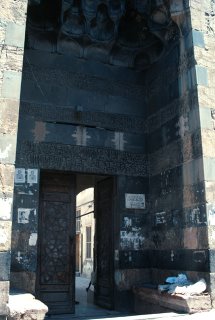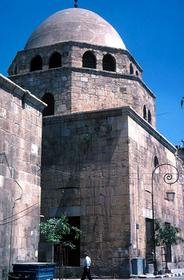

Al-Madrasa al-Zahiriyya was originally a residential home that was transformed to a madrasa in 1277 after the death of Mamluk ruler Al-Zahir Rukn al-din Baybars al-Bunduqdari, or Baybars I (1260-1277), who is famous for the conquest of most of the Levant from the Crusaders. The king was buried in an elaborate mausoleum with a high dome in the southwest corner of the building.
The history of the building, which dates from the late 13th century, is probably more interesting than the holdings of the library itself. One of the largest and best preserved of the Damascene madrasas, al-Zahiriyya was named for Sultan al-Zahir Baybars, the first of the Mamluks sultans. In 1876 it was turned into a general library. Along with al-'Adiliyya Madrasa, across the street, it was also headquarters of al-Majma' al-'Ilmi al-'Arabi, the premier institution of the Syrian literary renaissance of the late 19th and early 20th centuries.

The madrasa is richly decorated using various materials and techniques. The main entrance gate is semi-domed with stone muqarnas. The interior ornamental program consists of marble revetment, carved stucco, gilt wood and a continuous frieze of glass mosaic that depicts architectural ensembles on three of the four interior walls, along with vases, trees, and other stylized vegetal motifs. The mihrab in the mausoleum is made of colored marble to allude to patterns and mosaics typical of the Mamluk architectural style.
the name of the mausoleum's architect, Ibrahim b. Ghana'im, is carved into the muqarnas hood of the monumental entrance portal.
The Zahiriyya collection was decimated, however, by the creation of the Asad Library when the manuscript collection, rare books and periodicals relating to Syria were transferred to the Asad Library. The Zahiriyya now contains about 70,000 volumes mostly related to Islam, the Arabic language, history and biography. The library is now used mostly by high school and college students.
I have lots of memories in that Library for I spent many times studying there with friends and I just love it :)
Sources from Middle East Studies Association Bulletin
3 comments:
Reading articles like this makes me feel good about my country, bad about myself. I, like many others, know so much more about the rest of the world than I know about our own backyard. I'm very familiar with the treasures of the Syrian cost and the famous Syrian sites. It's a shame that most of my trips to Damascus and other Syrian cities are on business. The only time I get to see one of these wonderful treasures is when I have foreign company with me and it usually is after work is done.
Thanks Soraya, you have given me an additional motivation to visit as many of these wonderful places as possible.
Ciao
Nice one,
i remeber that i have been there a couple of times....long time ago.
nice place,
Is it located close to the Omayad Mosque , around the Asrunieh ? If that's the one , I must have passed it by houndreds of times without knowing what secrets hide inside it's walls . I must go check .
Post a Comment